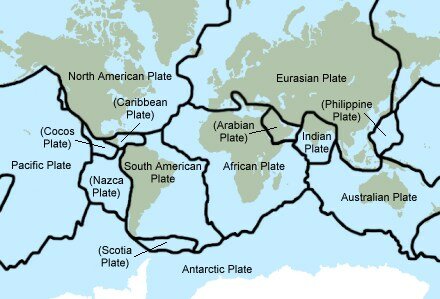
Figure 1: The Earth's Tectonic Plates
by Leigh Tremaine
The Earth's outermost crust (the lithosphere) is divided into tectonic plates that are in constant motion. The boundaries between these plates (fault lines) give rise to some of the world's most powerful earthquakes and volcanoes. There are seven major plates (Eurasian, African, Indian, Pacific, North American, South American, Antarctic) and many minor ones (e.g. Philippine, Nazca, Aegean).

While it is true that seismic activity is the result of natural geological processes, we need to consider to what extent we exacerbate or ameliorate these effects. For instance, on May 30, 1998, two days after Pakistan conducted five underground nuclear tests in response to those carried out by India earlier in the month, neighbouring Afghanistan was struck by a strong earthquake that was to result in the deaths of 5000 people.
However, a more revolutionary idea also has to be considered. As a result of the new worldview that is emerging, there is a growing belief that our consciousness can interact with a subtle energy that underlies and sustains physical reality. Consequently, just as stress in our own body's subtle energetic field can eventually manifest as physical illness, it is believed that collective stress can affect the subtle energetic field of the Earth, contributing to the physical manifestation of geological turbulence. Perhaps the collective stress produced by NATO's bombing of Yugoslavia, which began on March 24, 1999, was a contributing factor to the earthquake that struck Serbia during the Full Moon of April 30, just hours after one of the most heaviest bombardments of the capital. Similarly, perhaps the brutal oppression and massacre of civilians by the pro-Indonesian militia in East Timor during September 1999 produced a sufficiently stressful energy field to precipitate the major earthquake that struck Taiwan on September 20, killing over 2000 people, for Taiwan is joined to Indonesia by the Philippine Sea Plate (see diagram).
It would be interesting to correlate the frequency and magnitude of seismic activity with the degree of stress generated by world events, although this would admittedly be a complex task in practice, for such a study would not only have to find a way of measuring collective stress, it would have to take into account such factors as the time-lag between cause and effect, the Earth's own cycles (however little we understand them), the effect of any planetary alignments, and any concurrent efforts to help heal the stress (including world peace meditations). The effect of planetary alignments is a serious point: the earthquake that struck Turkey on August 17, 1999 occurred when all of the planets in our solar system but Pluto aligned to form a 'Grand Cross', with the Earth at the centre. Interestingly, this was just days after Turkey experienced the Total Solar Eclipse of August 11, which was part of a similar alignment. From an astrological viewpoint, certain geometric alignments between planets, or between planets and signs, create a resonant field that can increase the tendency for turbulence within the Earth to occur. Alignments between Saturn and Uranus are considered significant in this respect, an example of which occurs between May 1999 and July 2000, and between December 2000 and April 2001, when the two planets are around 90° apart. It would be useful to chart the frequency and magnitude of earthquakes during this period, and to compare the results with average statistics.
By looking at the Earth's geological (and meteorological) systems from this wider perspective, they appear as barometers for the level of stress within the Earth's subtle energetic field, and natural disasters are seen as signals to us to become more aware of the quality of our thoughts and actions, which send out ripples through this field. This reminds us that we are part of the Earth, not separate from it.
To minimise the stress between tectonic plates, it would be helpful in meditation to direct peaceful healing energies to the Earth's fault lines, perhaps using the diagram above. This technique would be particularly valuable when used in the aftermath of earthquakes to minimise the power of any aftershocks. The epicentre of an earthquake itself, and the tectonic plates associated with it, could be used as marker points for directing healing energy into the Earth's energy field. However, the most important insight that we can gain from learning about the Earth's geological (and meteorological) response to the stress we generate is that our materialistic worldview, with its notion of atomistic relations, is not working. Today a new holistic worldview is beginning to emerge across the planet that can enable us to heal and transform our collective consciousness.
For news of seismic activity visit:
Discovery Channel Online
Seismo-Watch Earthquake Information Services
United States Geological Survey National Earthquake Information Center